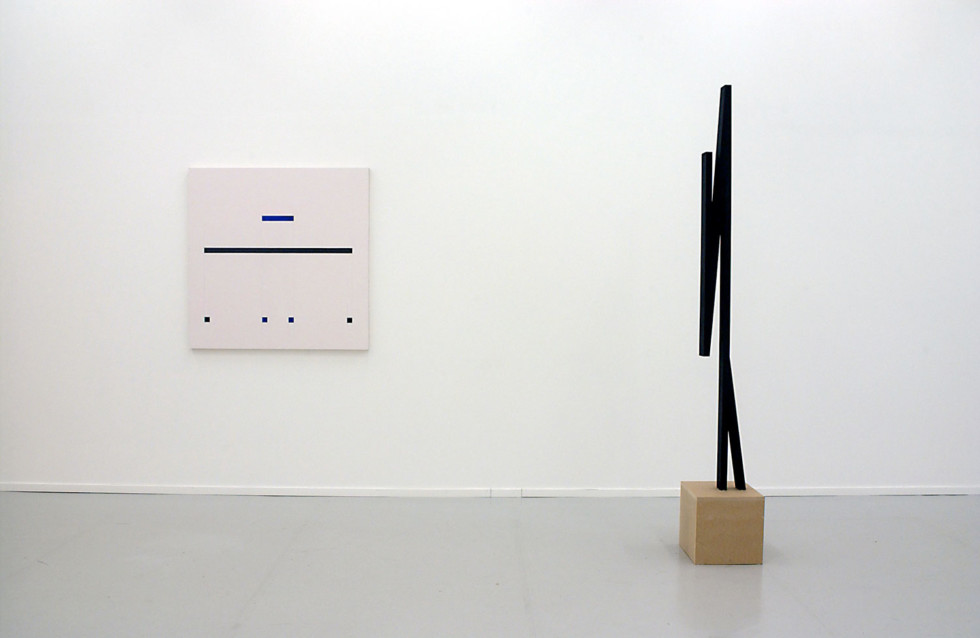
Lars Olof Loeld, Visit Photo: Prallan Allsten/Moderna Museet © Lars Olof Loeld
Odd weeks: Lars Olof Loeld
Visit. Size the dew!
2.12 2002 – 15.12 2002
Stockholm
He belongs to a branch of abstract art that searches for signs of an inner reality. Not for “pure form”. His works present riddles, puns, observations, moods. He may appear esoteric, as though his art is only for the initiated. But it is about the secret embedded in everyday phenomena – once you begin to see through his works, out to the paradise lost to which they open the door, it is impossible to avoid it. And yet, we remain in the image. In the pink background and the blue, grey or dark grey figures that prevent our gaze from losing its grip in the endless pink.
He is a poetic alchemist. Makes gold himself! Likes to refer to Mutus Liber, “The Mute Book”, from the 16th century, in which the illuminations tell of the alchemic siblings who collect morning dew in large cloths, which they wring out to collect the water in vessels. Dew is the result of the meeting between the rising sun and the dark night; the result of nocturnal damp and the sun’s fire, the amalgamation of opposites in a fifth element: “Quinta essentia” – yes, the very quintessence, as we say, even you and I. Alchemy contains both what happens – a transformative art – and the principle of how it happens: a system of symbols. Lars Olof Loeld applies it light-heartedly. (Naturally, he is not an alchemist in the sense that he tries to produce gold in the form of a metal.)
Loeld quotes King Gustav III’s general, Carl August Ehrensvärd, remembered mainly as a draughtsman: Out of what matter can one create order for the eye? Out of all matter. One can, by merely using dots, achieve order for the eye.
Loeld is a spokesman of simple order. He comes calling with an old-fashioned suitcase. Inside is a bicycle tube, an iron peg, a bottle; six toy porcelain chamber pots from Taiwan, a paintbrush and paint. With these “dots” he “achieves” “order”. A paraphrase, a meditation on Marcel Duchamps’s so-called ready-mades. That is, familiar objects torn from their usual context, changed, displaced, so that they get a new meaning. The Bottle Rack, the Urinal, the Bicycle Wheel – in Loeld’s developing objects they are all there, through the parts that are invisible in the original, the bicycle tube, the bottle, the holes in the urinal that have turned into porcelain chamber pots.
His subject is the hidden elements of the picture and the silence in the poem. His aim is to make spiritual gold out of Beckers standard paint. To bring dead matter to life. That’s what it means to make art. And you, the viewer, are invited! This is how it is done, according to Loeld’s own example: When you hear the cock crow, it is not the cock you see, but the cock you hear. And the image is evoked. Since you can interpret the sound as a sign, inside you. That’s the whole secret. Those who, so to speak, pay heed to their observations will soon find that a new world opens to them. Meanings are superimposed on one another, and the objects mean many different things.
With Loeld, simple shapes contain one of the most obvious motifs in art: a sunset. Divested of naturalism but close to nature, the landscape by the sea emerges through a system of signs. Pink for the sky (fire and air); ultramarine for the horizontal ocean; grey and dark grey for the ground, earth, trees (as sculptures) and man – upright, at an angle to the surface of the earth and against the horizon. As the picture emerges silence erupts.
Oh, do not ask, ´What is it?’ / Let us go and make our visit. *
Sören Engblom
*T.S. Eliot: from The Love Song of J. Alfred Prufrock
